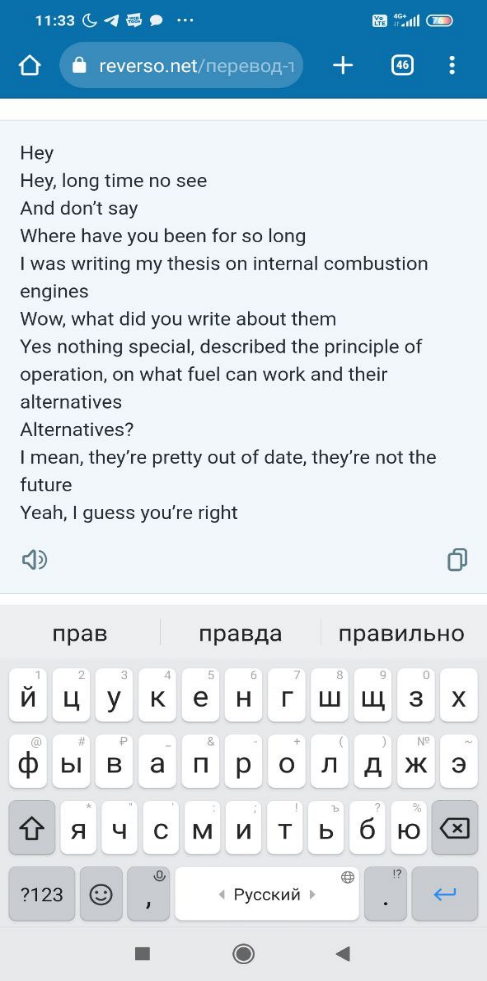
13.03.02 Электроэнергетика и электротехника / Английский / 3 симестр / 9-22-2023
.docx1.
- I know you study at the energy faculty. Can you explain to me what conductors and insulators are?
- Sure. A conductor is a material that offers very little resistance to electric current, meaning it conducts electricity. An insulator, on the other hand, is a material that offers very high resistance to electric current. Practically, it does not conduct current.
- As I understand it, a semiconductor is something in between a conductor and an insulator. What material can be a good conductor, insulator, and semiconductor?
- Metals are good conductors. Good insulators are glass and plastics. Usually used semiconductor materials are silicon, germanium, and cadmium sulfide.
2.
- Interesting, what are you doing?
- I'm preparing for an electrical engineering exam. As far as I remember, you've already passed it. Can you test me, please?
- Okay. How does electric current depend on voltage?
- Well, that's easy. The higher the voltage of the source, the greater its potential to produce current in the circuit.
- Correct. And what is potential difference?
- The electric potential between two points in the circuit is known as potential difference. And the voltage that produces current is electromotive force.
- And current is the liquid that flows inside wires, right?
- Well, no, you won't fool me. Current in the circuit arises due to the movement of positively charged particles towards the negatively charged pole.
- Great! I wonder why you didn't pass this exam on your first attempt.
Great! I wonder why you didn't pass this exam on your first attempt.
Unit 2:
№2:
1. Static electricity is not a steady continuous current and cannot be controlled or directed to perform specific tasks, unlike electric current.
2. Voltage can be increased and decreased in alternating current, making it more versatile for different applications.
3. The unit of electric pressure is called the volt in honor of Italian physicist Alessandro Volta who invented the first battery, which produced a steady current.
4. Learning English is important for communication and understanding in a globalized world. However, this topic is unrelated to electric current.
5. Ampere was wrong about the direction of the current because he assumed it flowed from positive to negative, but in reality, it flows from negative to positive.
6. This statement contradicts the previous statement about Ampere's mistake. The current actually flows from negative to positive, not from positive to negative.
№6:
1. The electric current is the flow of moving electrons.
2. Kinetic energy is the energy of motion.
3. Static electricity is electricity at rest.
4. Potential energy is the energy of position.
5. The direct current is a steady continuous flow of electricity.
6. Lightning is a discharge of electricity in one direction.
№3
1. Electrons flow from the negatively charged terminal of the battery to the positively charged terminal.
2. Ampere supposed the current to flow from the positive pole to the negative pole.
3. Static electricity is not commonly used for practical purposes.
4. Static electricity can have high voltage and can be difficult to control.
5. Franklin decided to call the charge on the rubber negative and that on the glass positive.
6. Galvani thought that electricity was generated because of the contact of dissimilar metals with an electrolyte.
7. Volta took great interest in electrochemistry and began to carry out experiments.
8. The direct current flows in one direction only.
9. The direct current used for power and lighting purposes does not have cycles per second, as it is a steady flow.
1. Электроны перетекают от отрицательно заряженной клеммы аккумулятора к положительно заряженной клемме.
2. Ампер предположил, что ток течет от положительного полюса к отрицательному.
3. Статическое электричество обычно не используется в практических целях.
4. Статическое электричество может иметь высокое напряжение, и его может быть трудно контролировать.
5. Франклин решил назвать заряд на резине отрицательным, а заряд на стекле положительным.
6. Гальвани считал, что электричество вырабатывается из-за контакта разнородных металлов с электролитом.
7. Вольта проявил большой интерес к электрохимии и начал проводить эксперименты.
8. Постоянный ток течет только в одном направлении.
9. Постоянный ток, используемый для питания и освещения, не имеет циклов в секунду, так как это постоянный ток.
